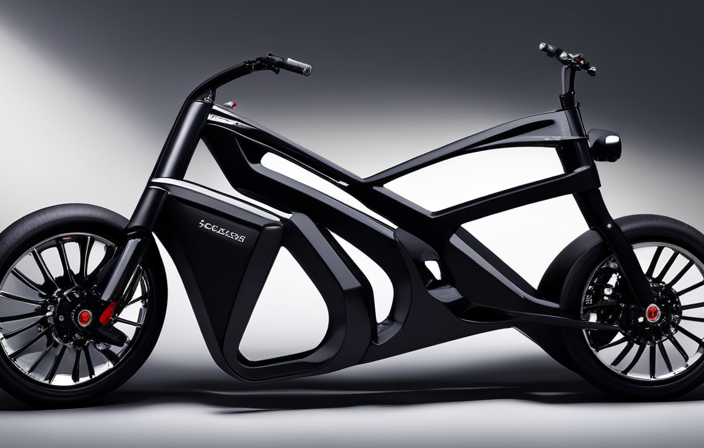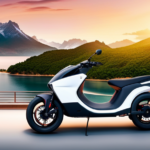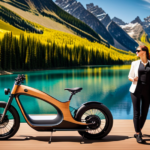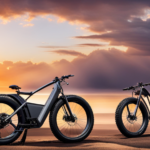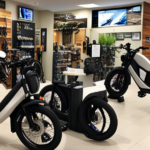Are you ready to embark on an electrifying journey? Buying an electric bike is like discovering a new path to freedom and adventure. Just imagine effortlessly gliding through city streets or conquering challenging terrains with ease.
But before you hop on the saddle, it’s important to know what to look for. In this guide, we’ll unveil the key factors to consider when purchasing an electric bike. From battery range to frame size, we’ll empower you with the knowledge to make an informed decision.
So, let’s dive in and find the perfect electric companion for your thrilling rides ahead.
Key Takeaways
- Determine your riding needs and style
- Assess battery range and motor power
- Evaluate frame size and weight capacity
- Consider the terrain and inclines you’ll encounter
Determine Your Riding Needs and Style
When buying an electric bike, it’s important to determine your riding needs and style. Consider the various riding styles you enjoy, such as commuting, mountain biking, or leisurely rides around the neighborhood. This will help you choose the right type of electric bike that suits your preferences and needs.
Additionally, think about bike customization options that are important to you, such as adjustable handlebars, seat height, or suspension settings. These features can greatly enhance your riding experience and ensure maximum comfort and control.
Once you have determined your riding needs and style, you can move on to assessing battery range and motor power, which are crucial factors in choosing the right electric bike for you.
With a solid understanding of your preferences, you can make an informed decision and find the perfect electric bike that meets your specific requirements.
Assess Battery Range and Motor Power
When assessing battery range and motor power for your electric bike, it’s important to determine the distance you need to travel on a single charge. Consider the terrain and inclines you’ll encounter on your rides, as this will impact the battery’s performance.
Additionally, it’s crucial to research different motor types and their power capabilities to ensure they meet your specific riding needs.
Determine the distance you need to travel on a single charge
To determine the distance you need to travel on a single charge, it’s important to consider factors such as battery capacity and terrain.
Battery capacity refers to the amount of energy the battery can store, and it plays a crucial role in determining how far your electric bike can go on a single charge. The higher the battery capacity, the longer the distance you can cover.
Additionally, charging time is another important factor to consider. Some batteries may take longer to fully charge, which can impact your travel plans if you need to recharge frequently.
Once you have assessed the battery capacity and charging time, you can move on to considering the terrain and inclines you’ll encounter. This will help you determine the overall range and performance of the electric bike.
Consider the terrain and inclines you’ll encounter
Take into account the terrain and inclines you’ll come across to determine how your electric bike will perform. When considering the terrain, think about whether you’ll be riding on mostly flat roads or if you’ll encounter hilly areas. This will help you decide on the right motor power for your electric bike.
If you’ll be riding on steep inclines, you’ll need a more powerful motor to assist you in climbing those hills. Additionally, consider battery life when choosing an electric bike. Riding on hilly terrain can drain the battery faster, so it’s important to choose a bike with a battery that has enough capacity to support your needs.
In the next section, we will discuss different motor types and their power capabilities, which will further assist you in making an informed decision.
Research different motor types and their power capabilities
Consider researching various motor types and their power capabilities to help you make an informed decision about which one is best suited for your needs. When it comes to electric bikes, motor efficiency is crucial. Look for a motor that offers high efficiency, as this will ensure better performance and longer battery life. Additionally, pay attention to the motor’s power capabilities. Different motors provide varying levels of power, so choose one that matches the intensity of your rides.
Now, let’s dive into a few reasons why motor efficiency and power capabilities matter:
-
More efficient motors can offer a smoother and quieter ride, enhancing your overall biking experience.
-
A powerful motor will effortlessly tackle steep inclines and challenging terrains, making your rides more enjoyable.
-
Opting for a motor with high power capabilities will minimize battery drain, resulting in longer rides and less frequent charging.
Considering motor efficiency and power capabilities will play a significant role in selecting the right electric bike for you.
Now, let’s move on to evaluating frame size and weight capacity.
Evaluate Frame Size and Weight Capacity
When buying an electric bike, it’s important to evaluate the frame size and weight capacity. The frame material and weight distribution play a crucial role in determining the bike’s stability and comfort. A sturdy frame made of materials like aluminum or carbon fiber ensures durability and reduces the overall weight of the bike. Consider the type of riding you’ll be doing and choose a frame size that suits your body type and riding style. To assist you in making an informed decision, here’s a table summarizing different frame sizes and weight capacities:
| Frame Size | Rider Height | Weight Capacity |
|---|---|---|
| Small | 5’0" – 5’5" | Up to 250 lbs |
| Medium | 5’6" – 5’10" | Up to 300 lbs |
| Large | 5’11" – 6’4" | Up to 350 lbs |
| X-Large | 6’5" and above | Up to 400 lbs |
Considering the type of pedal assist system is the next crucial step in choosing the perfect electric bike for your needs.
Consider the Type of Pedal Assist System
When considering the type of pedal assist system for your electric bike, you have two main options to choose from: torque sensor and cadence sensor systems.
The torque sensor system measures the force you apply to the pedals and adjusts the motor assistance accordingly, providing a more natural and responsive ride.
On the other hand, the cadence sensor system detects the speed at which you pedal and provides a predetermined level of assistance, which may not be as intuitive.
Additionally, it’s important to understand the different levels of pedal assist available, as some bikes offer multiple levels that allow you to customize the amount of assistance you receive based on your preferences and the terrain you’re riding on.
Choose between torque sensor and cadence sensor systems
One important factor to keep in mind is the type of sensor system used in the electric bike, as it can greatly impact the overall performance and riding experience. When choosing between a torque sensor and a cadence sensor system, it is essential to consider the pros and cons of each.
-
Torque sensor: This system measures the force applied to the pedals and provides a proportional amount of assist. It offers a more natural and intuitive riding experience, as the motor responds to the rider’s effort in real-time. However, torque sensor systems tend to be more expensive.
-
Cadence sensor: This system measures the rotation of the pedals and provides assistance based on a predetermined speed. It is more affordable and simpler, but it may not offer as smooth or precise assistance as a torque sensor system.
Understanding the difference between these two types of sensor systems will help you make an informed decision.
Now, let’s move on to understanding the different levels of pedal assist available.
Understand the different levels of pedal assist available
To understand the different levels of pedal assist available, you should familiarize yourself with the various options for adjusting the amount of assistance provided while riding.
Pedal assist customization is an important feature to consider when buying an electric bike. Some bikes offer multiple levels of assistance, allowing you to choose how much power you want the motor to provide. This is particularly useful if you want to conserve battery life and extend your range.
Additionally, some bikes also have the option to fine-tune the level of assistance within each setting, giving you even more control over your riding experience.
When examining the quality of components, you should also consider the pedal assist system and its ability to optimize battery life.
Now, let’s move on to the next section and examine the quality of components.
Examine the Quality of Components
Inspecting the quality of the components when purchasing an electric bike is crucial in assessing durability and comparing performance. To ensure you’re getting a top-notch electric bike, pay attention to the following:
- Frame material: Look for a sturdy and lightweight frame made of materials like aluminum or carbon fiber.
- Motor type: Opt for a high-quality motor from reputable brands like Bosch or Shimano for reliable performance.
- Battery capacity: Consider the battery’s range and charging time, as well as the brand’s reputation for longevity.
- Braking system: Check if the electric bike is equipped with reliable disc brakes for efficient stopping power.
By scrutinizing the quality of these components, you can make an informed decision when purchasing an electric bike.
Once you have assessed these factors, it’s time to test ride and compare models, which we will discuss in the next section.
Test Ride and Compare Models
When it comes to buying an electric bike, it’s important to test ride and compare different models before making a decision.
Visit local bike shops to try out a variety of electric bikes and get a feel for their features, comfort, and ride quality.
By doing so, you can make an informed choice and find the electric bike that best suits your needs and preferences.
Visit local bike shops to try out different electric bikes
Check out your local bike shops and test ride various electric bikes to find the right one for you. This is a great way to get a feel for different models and see how they handle on the road. In addition to the electric bike rentals, you can also explore online electric bike retailers to get an idea of the different options available.
When visiting the bike shops, take note of the following:
-
Look for a shop that has a wide selection of electric bikes to try out. This will give you the opportunity to compare different models and find the one that suits your needs.
-
Pay attention to the range and power of the electric bikes. Some bikes have a longer range and more power than others, so it’s important to find one that matches your intended use.
-
Consider the comfort and ergonomics of the bike. Make sure the seat is comfortable and the handlebars are at a comfortable height.
-
Test the ride quality of the bike. Take it for a spin and see how it handles on different terrains.
Once you have test ridden a few electric bikes and found some models you like, you can move on to comparing their features, comfort, and ride quality.
Compare features, comfort, and ride quality
Now that you have visited local bike shops and tried out different electric bikes, it’s time to compare their features, comfort, and ride quality. This step is crucial in ensuring that you choose the right electric bike that meets your needs and preferences.
To make this process easier, you can use the following table to compare the different electric bikes you have tried:
| Features | Comfort | Ride Quality |
|---|---|---|
| Battery Life | Seat Cushioning | Suspension |
| Motor Power | Handlebar Design | Tires |
| Frame Material | Riding Position | Braking System |
When comparing features, consider elements such as battery life, motor power, and frame material. Assess comfort by examining seat cushioning, handlebar design, and riding position. Pay attention to ride quality by evaluating suspension, tires, and the braking system.
Additionally, take into account electric bike design, including the battery charging options available. This will ensure that you choose an electric bike that aligns with your lifestyle and preferences.
Now that you have compared the different electric bikes, it’s time to delve into the next step: researching and reading reviews.
Research and Read Reviews
One important step is to research and read reviews from other electric bike owners. This will give you valuable insight into the pros and cons of different models and help you make an informed decision.
Here are some things to consider when reading reviews:
-
Performance: Look for reviews that discuss the bike’s speed, power, and range. This will give you an idea of how well it will perform in different conditions.
-
Battery Life: Find out how long the battery lasts and how easy it is to recharge. This will help you determine if the bike can meet your needs for daily commuting or long rides.
-
Build Quality: Pay attention to reviews that mention the durability and reliability of the bike. You want to invest in a brand that will last and stand up to regular use.
-
Customer Service: Research the reputation of the manufacturer and read reviews about their customer service. This will be important if you need assistance or repairs down the line.
Considering these factors will help you make an informed decision about which electric bike is right for you. Once you have read the reviews, you can move on to determining the level of maintenance required for your chosen bike.
Determine the Level of Maintenance Required
To determine the level of maintenance required, you should consider factors such as how often you will need to perform maintenance tasks and the cost of replacement parts. Electric bikes generally require less maintenance compared to traditional bikes, but it is still important to be aware of the level of upkeep involved.
One important aspect to consider is the battery life of the electric bike. Different models have varying battery capacities and lifespans, so you should choose one that suits your needs and budget.
Additionally, it is important to factor in the cost and availability of replacement parts. Some electric bikes may have specialized parts that are more expensive or harder to find.
By considering these factors, you can determine the level of maintenance required for your electric bike.
Now, let’s move on to setting a budget and comparing prices.
Set a Budget and Compare Prices
Setting a budget and comparing prices is essential when purchasing an e-bike. Electric bike prices can vary greatly depending on the brand, features, and quality. When setting a budget, there are several factors to consider.
Firstly, determine how much you are willing to spend on an electric bike. Consider your needs and preferences, as well as the intended use of the bike.
Next, research and compare prices from different retailers and online platforms. Take note of any ongoing promotions or discounts that may be available. Additionally, consider the long-term costs such as maintenance and replacement parts. It’s important to strike a balance between your budget and the quality and features you desire.
After considering the pricing aspect, it’s crucial to also consider after-sales support and warranty to ensure a satisfactory purchase.
Consider After-Sales Support and Warranty
When considering an electric bike purchase, it’s important to look for a reputable brand that offers good customer service. You want to make sure that if any issues arise with your electric bike, you can easily get the support you need.
Additionally, checking the warranty coverage and terms is crucial. Understanding what is covered and for how long will give you peace of mind and protect your investment.
Look for a reputable brand that offers good customer service
One thing to consider is finding an electric bike brand that has a good reputation and offers excellent customer service. Customer satisfaction is an important factor when purchasing an electric bike, as it reflects the brand’s commitment to providing a quality product and addressing any issues that may arise.
A reputable brand not only offers reliable and durable electric bikes, but also ensures that customers have a positive experience throughout their ownership. This includes prompt and helpful customer service for any inquiries or concerns. When researching electric bike brands, look for customer reviews and testimonials to gauge the brand’s reputation and level of customer satisfaction. It’s also a good idea to reach out to the brand directly to inquire about their customer service policies and practices.
By choosing a brand that prioritizes customer service, you can feel confident that any issues or questions you may have will be addressed promptly and effectively.
Now, let’s move on to checking the warranty coverage and terms for the electric bike.
Check the warranty coverage and terms for the electric bike
To ensure you have peace of mind, make sure to check the warranty coverage and terms for your new electric bike.
Assessing the warranty coverage is crucial as it determines the extent to which the manufacturer will take responsibility for any defects or damages. Look for a warranty that covers the major components of the electric bike, such as the motor, battery, frame, and electronics.
It’s also important to compare the warranty terms among different brands. Some warranties may offer longer coverage periods, while others may have more comprehensive terms. Pay attention to any limitations or exclusions in the warranty, such as damage caused by accidents or misuse.
Additionally, check if the warranty includes provisions for repairs or replacements, and whether it requires you to bear any costs.
By carefully evaluating the warranty coverage and terms, you can make an informed decision and protect your investment in the electric bike.
Frequently Asked Questions
Can I use an electric bike for commuting long distances?
Yes, you can use an electric bike for commuting long distances. Electric bike range varies, but most can cover 40-60 miles on a single charge. The benefits include saving money, reducing carbon emissions, and avoiding traffic congestion.
How long does it take to fully charge the battery of an electric bike?
Charging time for an electric bike battery varies depending on the model, but it typically takes around 4-6 hours for a full charge. It’s important to note that frequent fast charging can reduce the battery lifespan, so it’s best to charge it fully and avoid overcharging.
Are there any restrictions or regulations on using an electric bike on public roads?
Yes, there are restrictions and regulations on using an electric bike on public roads. These can vary depending on your location, but common regulations include speed limits, age restrictions, and requirements for lights and reflectors.
Can I use an electric bike for off-road adventures and trail riding?
Yes, you can use an electric bike for off-road adventures and trail riding. The maintenance for electric bikes is relatively simple, and the benefits of using one for off-road riding include enhanced power, longer range, and a smoother ride.
How often should I expect to replace the battery of an electric bike?
You can expect to replace the battery of an electric bike every 2-4 years, depending on factors like usage, terrain, and battery quality. Battery lifespan is influenced by these factors, so it’s important to consider them when purchasing an electric bike.
Conclusion
So there you have it, dear reader. After carefully considering all the factors mentioned above, you’re now ready to embark on the exciting journey of purchasing an electric bike.
Don’t worry, it’s not like there’s a plethora of options out there that can easily overwhelm you. And who needs a smooth and hassle-free buying experience anyway? Surely, spending hours researching, comparing prices, and reading reviews is everyone’s idea of a good time.
But hey, at least you’ll have the satisfaction of knowing you made the right choice. Happy pedaling!
